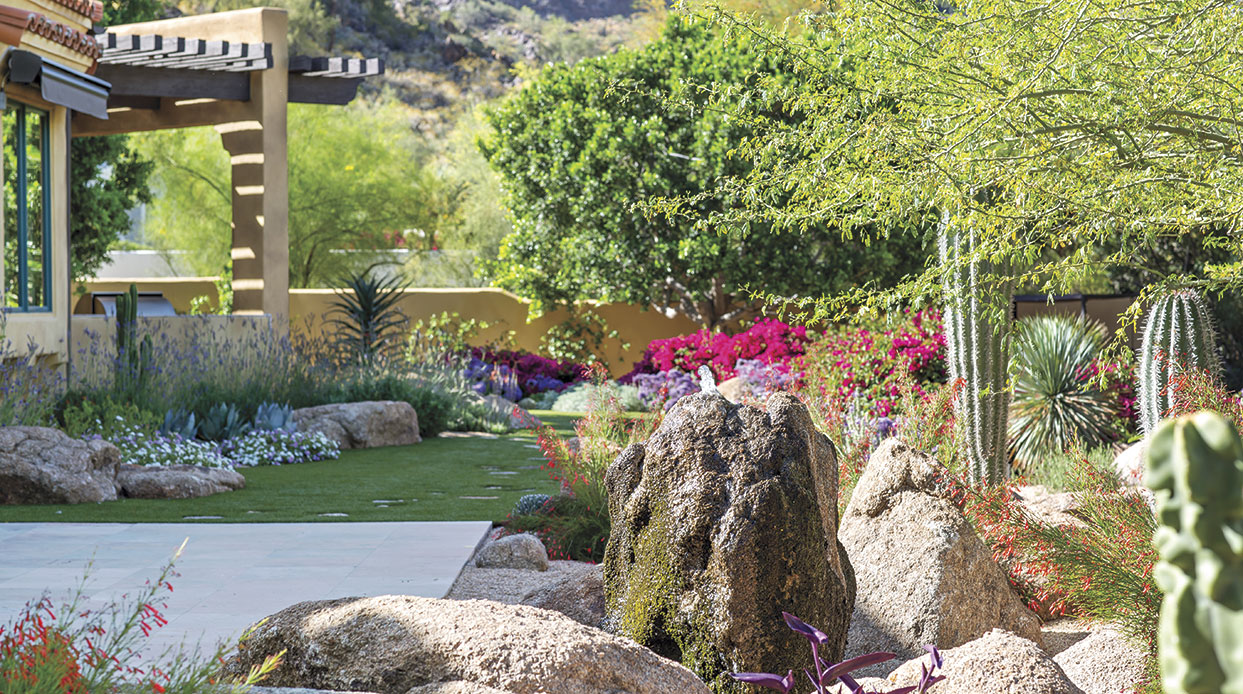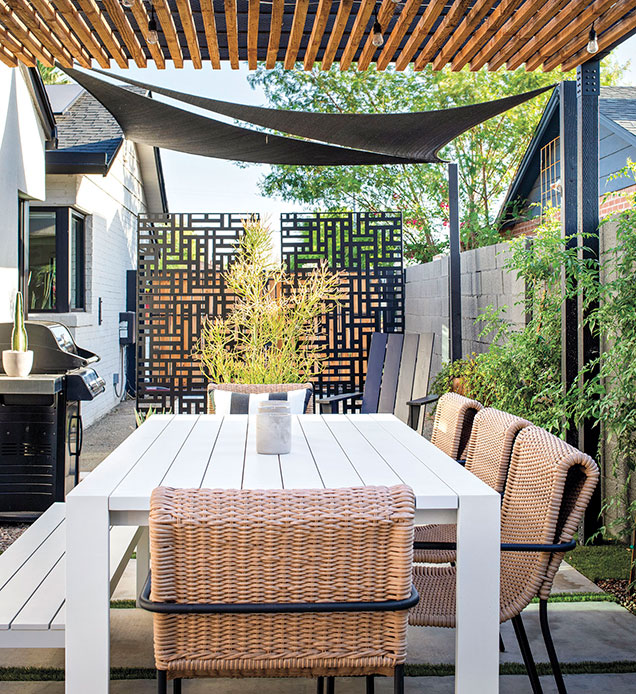A Passion for Plumeria
Cultivating this tropical stunner in your backyard may be easier than you think.
By John Roark | Photography by Christina Barrueta

Arizona’s climate is hospitable to plumeria. The tree boasts a dense green canopy and flowers in a wide range of colors. Here, homeowner Christina Barrueta’s Elsie (Plumeria rubra, ‘Elsie’) proffers a profusion of showy blossoms in shades of coral and pink.
For many, plumeria (Plumeria rubra and plumeria obtusa), also known as frangipani, brings to mind exotic vacations and visions of far-flung island destinations. The trees’ decadently scented, vibrantly hued flowers are also prominent in Hindu, Balinese, Buddhist and Indian cultures and carry symbolic importance, including wealth, immortality, everlasting love and the sheltering of spirits.
Originating in South America and Mexico and brought to America by Spanish priests in the 1800s, the ornamental trees thrive in climates with arid soil and abundant sunshine and can also flourish here in Arizona. With a distinctive umbrella canopy and more than 2,000 colorful bloom varieties to choose from, the tree has a loyal following of devotees.
“As is the case for many people, my first introduction to this plant was when I was given a plumeria lei at the airport in Hawaii,” says Michele Wilcox, an enthusiast who helmed the Valley of the Sun Plumeria Society from 2003-2013. “I was instantly hooked.”
Some of Phoenix’s most celebrated examples of this distinctive flora can be seen at the Royal Palms Resort and Spa. Blossoming in several spots throughout the property, including the front courtyard, the towering, bloom-studded trees provide a popular photo opportunity for visitors and locals alike. Landscape architect Greg Trutza, who restored

Dwarf pink Singapore (Plumeria obtusa ‘Dwarf Singapore Pink’)
the property’s main gardens in 1996, attributes the plants’ success to optimal microclimate conditions. Protected by Camelback Mountain’s south side, the trees are sheltered from cold, which is their worst enemy. “Find the right spot, and plumeria will really thrive,” the Phoenix Home & Garden Masters of the Southwest award winner says. “A frost-free environment, well-drained, porous soil and about six hours of morning sun every day can reward Arizona gardeners with a robust floral display from late spring through November—even later if we have a mild winter.”
Valley homeowner Christina Barrueta has owned, by her estimation, more than 200 plumeria. “I had a potted plant for years when I lived in a Boston high-rise,” she recalls. “It grew nicely, but I don’t think it ever bloomed. That baby rode in the back seat as my husband and I drove across the country when we relocated to Arizona. We’d bring it into our hotel room when we would stop for the night. In 2012, we had our back patio redone, and I had a custom bed made specifically for this plant. Once I placed the plant into the ground, it probably tripled in size in one year. Every branch had flowers on it.”
PLUMERIA PARTICULARS
TYPE: Perennial tree
ELEVATION: Middle
BLOOMS: Summer through early winter
SIZE: 20’H by 20’W
SOIL: Well-drained, porous
LIGHT: Morning sun or filtered shade
WATER NEEDS: Low
MAINTENANCE: Protect from frost
ATTRACTS: Bees
NOTE: Sap can irritate skin and is toxic to pets.
1. Monterrey (Plumeria rubra ‘Monterrey’) 2. The flowers of the Queen Amber (Plumeria rubra ‘Queen Amber’) have a delicate coconut scent. 3. Jackie’s (Plumeria rubra ‘Jackie’) blooms feature curled petals with pointed tips.
In addition to the plumeria’s vast array of bloom colors, which range from white to pink, orange, crimson and fuchsia, gardeners are also drawn to the plant’s variety of fragrances. “I have ones that are scented like coconut, cinnamon, cotton candy and gardenia. One of my favorites smells so much like ripe peaches it makes my mouth water,” Barrueta says.
For those taking their first foray into growing plumeria, Wilcox recommends starting with a potted plant, which can be transplanted into the ground when it eventually outgrows its container. Care, she says, is fairly straightforward. “Plumeria are found in regions all over the world and are relatively easy to grow here if you know what they need,” she says. “There are no secret formulas. The basics are well-drained soil, morning sun and not overwatering.”
Trutza advises a combination of caution and care. “Plumeria are succulents, so they are fairly rugged,” he explains. “But a plant purchased from a local home-improvement store may have been raised in a greenhouse in California. To survive here, it needs to be gradually conditioned to take our extreme climate. Get the plant established before the summer season in a pot situated where it can enjoy filtered or morning sunlight, such as beneath the canopy of a taller tree or under a slatted ramada. Similar to successfully growing sago palms, it’s amazing what you can get away with if you let them adjust to the sun over a few years.”
The patience, he says, is worth the effort. He also acknowledges that growing plumerias can border on obsession. “A lot of people get very passionate about them,” he observes.
Barrueta agrees. “The increase in interest in these flowers from when I moved here in 2008 until now is phenomenal. There’s an almost cultlike subculture surrounding them,” she says. Two online communities, Friendship Through Plumeria of Arizona and Phoenix Plumeria Growers and Sales, have combined memberships of more than 6,000

The microclimate at Phoenix’s Royal Palms Resort and Spa presents perfect growing conditions for plumeria. The trees are exposed to morning sun and afternoon shade, and Camelback Mountain protects them from frost.
followers. “There’s something that evokes happiness with this plant,” Barrueta adds. “And because they are fairly easy to get started, you can always just lop off a branch and give it to a friend. I’ve shared so many cuttings that there are now offspring from my garden all over the Valley.”
Michele Wilcox’s Top Growing Tips
- Don’t overwater. Plumeria are not happy with waterlogged roots. Whether potted or in-ground, these plants require good drainage. During hotter months, water every other day or when soil is dry at a depth of 3 inches.
- Watch the heat. Avoid placing trees near hot cement and excess direct sun. Potted plants on rollers can be moved throughout the day; keeping them in semishady locations, such as beneath a slatted ramada, work best.
- Feed during the warmer months. Once a month, April through October, apply a high-phosphate fertilizer, such as Miracle Grow or Bloom Booster.
- Protect from freezing. The No. 1 danger to these plants is frost. When temperatures dip below 32 degrees, cover them with frost cloth and, in extreme cases, place an outdoor heating unit nearby.

Desert Sunrise (Plumeria rubra ‘Desert Sunrise’) is a dependable bloomer with a fragrance reminiscent of grape candy.








